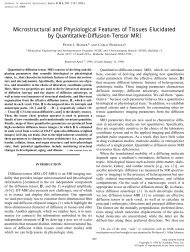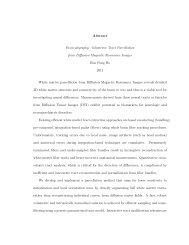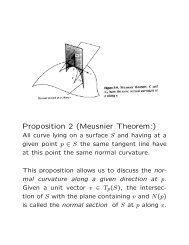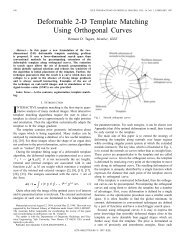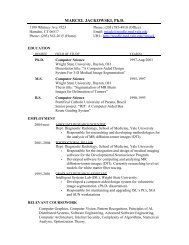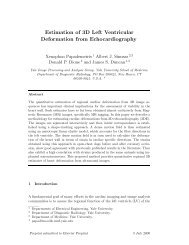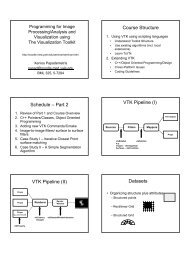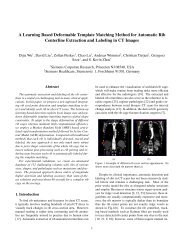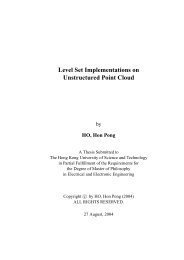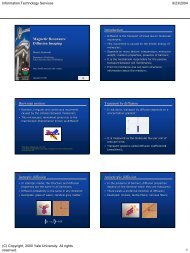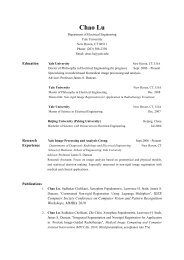SMASH, SENSE, PILS, GRAPPA
SMASH, SENSE, PILS, GRAPPA
SMASH, SENSE, PILS, GRAPPA
Create successful ePaper yourself
Turn your PDF publications into a flip-book with our unique Google optimized e-Paper software.
REVIEW<br />
<strong>SMASH</strong>, <strong>SENSE</strong>, <strong>PILS</strong>, <strong>GRAPPA</strong><br />
How to Choose the Optimal Method<br />
Martin Blaimer, Felix Breuer, Matthias Mueller, Robin M. Heidemann, Mark A. Griswold, and<br />
Peter M. Jakob<br />
Abstract: Fast imaging methods and the availability of required<br />
hardware for magnetic resonance tomography (MRT) have significantly<br />
reduced acquisition times from about an hour down to several<br />
minutes or seconds. With this development over the last 20 years,<br />
magnetic resonance imaging (MRI) has become one of the most important<br />
instruments in clinical diagnosis. In recent years, the greatest<br />
progress in further increasing imaging speed has been the development<br />
of parallel MRI (pMRI). Within the last 3 years, parallel imaging<br />
methods have become commercially available, and therefore are<br />
now available for a broad clinical use. The basic feature of pMRI is a<br />
scan time reduction, applicable to nearly any available MRI method,<br />
while maintaining the contrast behavior without requiring higher gradient<br />
system performance. Because of its faster image acquisition,<br />
pMRI can in some cases even significantly improve image quality. In<br />
the last 10 years of pMRI development, several different pMRI reconstruction<br />
methods have been set up which partially differ in their<br />
philosophy, in the mode of reconstruction as well in their advantages<br />
and drawbacks with regard to a successful image reconstruction. In<br />
this review, a brief overview is given on the advantages and disadvantages<br />
of present pMRI methods in clinical applications, and examples<br />
from different daily clinical applications are shown.<br />
Key Words: MRI, parallel imaging, <strong>SMASH</strong>, <strong>SENSE</strong>, <strong>PILS</strong>,<br />
<strong>GRAPPA</strong><br />
(Top Magn Reson Imaging 2004;15:223–236)<br />
Besides the image contrast, imaging speed is probably the<br />
most important consideration in clinical magnetic resonance<br />
imaging (MRI). Unfortunately, current MRI scanners<br />
already operate at the limits of potential imaging speed because<br />
of the technical and physiologic problems associated<br />
with rapidly switched magnetic field gradients. With the appearance<br />
of parallel MRI (pMRI), a decrease in acquisition<br />
From the Department of Physics, University of Würzburg, Würzburg, Germany.<br />
This work was funded by the Deutsche Forschungsgemeinschaft DFG JA<br />
827/4-2.<br />
Reprints: Martin Blaimer, Department of Physics, University of Würzburg,<br />
Am Hubland, 97074 Würzburg, Germany (email: mblaimer@physik.uniwuerzburg.de).<br />
Copyright © 2004 by Lippincott Williams & Wilkins<br />
time can be achieved without the need of further increased gradient<br />
performance.<br />
pMRI works by taking advantage of spatial sensitivity<br />
information inherent in an array of multiple receiver surfacecoils<br />
to partially replace time-consuming spatial encoding,<br />
which is normally performed by switching magnetic field gradients.<br />
In this way, only a fraction of phase-encoding steps<br />
have to be acquired, directly resulting in an accelerated image<br />
acquisition while maintaining full spatial resolution and image<br />
contrast. Besides increased temporal resolution at a given spatial<br />
resolution, the time savings due to pMRI can also be used<br />
to improve the spatial resolution in a given imaging time. Furthermore,<br />
pMRI can diminish susceptibility-caused artifacts<br />
by reducing the echo train length of single- and multi-shot<br />
pulse sequences.<br />
Currently, the newest generation of MRT scanners provide<br />
up to 32 independent receiver channels, which theoretically<br />
allow a 32× increased image acquisition speed compared<br />
with traditional MR systems without pMRI environment. At<br />
the moment, however, clinical routine experiments can only be<br />
accelerated by a factor 2 to 4, resulting in very good image<br />
quality. Higher scan time reductions can be achieved in threedimensional<br />
(3D) experiments (acceleration factors 5–8)<br />
where the number of phase-encoding steps can be reduced in<br />
two spatial dimensions. Further scan time reductions have<br />
been obtained at research sites using specialized hardware (acceleration<br />
factors 9–12). These new generation MRI scanners<br />
with pMRI have provided the greatest incremental gain in imaging<br />
speed since the development of fast MRI methods in the<br />
1980s.<br />
Over the last 10 years, great progress in the development<br />
of pMRI methods has taken place, thereby producing a multitude<br />
of different and somewhat related parallel imaging reconstruction<br />
techniques and strategies. 1–10 Currently, the most<br />
well known are <strong>SMASH</strong>, 1 <strong>SENSE</strong>, 2 and <strong>GRAPPA</strong>. 3 However,<br />
various other techniques, such as AUTO-<strong>SMASH</strong>, 4 VD-<br />
AUTO-<strong>SMASH</strong>, 5 GENERALIZED <strong>SMASH</strong>, 6 M<strong>SENSE</strong>, 7<br />
<strong>PILS</strong>, 8 and SPACE RIP 9 have also been proposed. All these<br />
techniques require additional coil sensitivity information to<br />
eliminate the effect of undersampling the k-space. This sensi-<br />
Top Magn Reson Imaging Volume 15, Number 4, August 2004 223
Blaimer et al Top Magn Reson Imaging Volume 15, Number 4, August 2004<br />
tivity information can be derived either once during the patient<br />
setup by means of a prescan or by means of a few additionally<br />
acquired k-space lines for every subsequent pMRI experiment<br />
(autocalibration), or some combination of the two. The present<br />
pMRI reconstruction methods can roughly be classified into<br />
two groups. Those in which the reconstruction takes place in<br />
image space (eg, <strong>SENSE</strong>, <strong>PILS</strong>) consist of an unfolding or inverse<br />
procedure and those in which the reconstruction procedure<br />
is done in k-space (eg, <strong>SMASH</strong>, <strong>GRAPPA</strong>), consist of a<br />
calculation of missing k-space data. However, hybrid techniques<br />
like SPACE RIP are also conceivable.<br />
There are many applications that have already seen remarkable<br />
benefits from the enhanced image acquisition capabilities<br />
of pMRI, such as head, thoracic, and cardiac imaging.<br />
But which pMRI method is best suited for any given clinical<br />
application?<br />
This review article is an attempt to give some answers to<br />
this question and might help a clinician to choose the optimal<br />
pMRI method for a specific application. At the beginning, a<br />
brief technical overview of the existing pMRI methods is<br />
given. Differences, similarities, advantages, and disadvantages<br />
will be discussed. However, the main focus will be put on<br />
the two present commercially available techniques, <strong>SENSE</strong><br />
and <strong>GRAPPA</strong>.<br />
Technical Overview of Current pMRI Methods<br />
In this article, a brief technical overview over the present<br />
pMRI reconstruction methods and strategies is given. However,<br />
to keep things as simple as possible, we confine ourselves<br />
to Cartesian-type sampled k-space, in which the number of<br />
phase-encoding steps is reduced by the reduction factor R by<br />
increasing the distance of equidistantly sampled k-space lines.<br />
To maintain resolution, the maximal k-values are left unchanged.<br />
In image space, this type of undersampling the kspace<br />
yields in a reduced field of view (FOV) in phaseencoding<br />
direction associated with foldover artifacts in the coil<br />
images as depicted in Figure 1.<br />
To provide a simple idea how pMRI operates, a simplified<br />
idealized example is given. Afterwards, the <strong>PILS</strong> method<br />
is introduced, which extends the simplified example into a<br />
real-world situation. Following this, the basics of <strong>SENSE</strong> will<br />
be presented. It is shown that <strong>SENSE</strong> can be seen as an “unfolding”<br />
algorithm in image domain. Thereafter, the development<br />
of k-space-related pMRI methods is described. Starting<br />
with basic <strong>SMASH</strong> theory, the development of autocalibrated<br />
pMRI techniques, such as AUTO-<strong>SMASH</strong>, VD-AUTO-<br />
<strong>SMASH</strong>, and <strong>GRAPPA</strong>, is presented. Finally, SPACE RIP as<br />
a hybrid technique is mentioned.<br />
pMRI: A Simplified Example<br />
To provide an intuitive comprehension of how an array<br />
of multiple receiver coils can be used to accelerate image acquisition,<br />
we begin with a simplified example.<br />
FIGURE 1. A, Conventional acquisition of fully sampled kspace,<br />
resulting in a full FOV image after Fourier transformation.<br />
B, Undersampled acquisition (R =2), resulting in a reduced<br />
FOV (FOV/2) with aliasing artifacts. Solid lines indicate<br />
acquired k-space lines, dashed lines indicate nonacquired kspace<br />
lines.<br />
Let us assume we have an array of N c = 2 independent<br />
receiver coils, each covering one half of the FOV with a boxcar-type<br />
sensitivity profile C k in phase-encoding direction<br />
(Fig. 2b). In this idealized setup, coil 1 detects only the top half<br />
of the object (Fig. 2c), whereas coil 2 detects only the bottom<br />
half of the object (Fig. 2d). A normal acquisition with just a<br />
single homogeneous volume coil would require N phaseencoding<br />
steps for a full FOV image of the object (Fig. 2a).<br />
Using the identical imaging parameters in the depicted twocoil<br />
situation, the resulting component coil images provide full<br />
FOV images with signal originating only according to the individual<br />
boxcar sensitivity profiles. In other words, coil 1 covers<br />
only one (half) part of the object in the full FOV image,<br />
while receiving no signal from the other (half) part of the object,<br />
while the opposite applies to coil 2.<br />
This fact can be used to halve the FOV, which means<br />
reducing the number of phase-encoding steps by a factor of<br />
R=2. As a result, two half FOV component coil images are<br />
simultaneously obtained in half the imaging time (Fig. 2e).<br />
Thus, the distinctiveness of the involved coil sensitivities allows<br />
a parallel imaging process.<br />
In a final reconstruction step, the component coil images<br />
can easily be combined to one full FOV image with full resolution<br />
by appropriately shifting the individual coil images (Fig.<br />
2f). This final image is then obtained in half of the imaging<br />
time (reduction factor R=2). The resulting signal-to-noise ratio<br />
(SNR) in the accelerated pMRI acquisition is reduced by a<br />
224 © 2004 Lippincott Williams & Wilkins
Top Magn Reson Imaging Volume 15, Number 4, August 2004 Choosing the Optimal pMRI Method<br />
FIGURE 2. A, Full FOV image with N phase-encoding steps<br />
(one homogeneous coil). B, Two-coil array with boxcar-type<br />
sensitivity profile. C, Full FOV image with N phase-encoding<br />
steps received in coil 1. D, Full FOV image with N phaseencoding<br />
steps received in coil 2. E, FOV/2 image with N/2<br />
phase-encoding steps received in coil 1 (top) and in coil 2<br />
(bottom). F, Combined coil images with full FOV and N/2<br />
phase-encoding steps.<br />
factor √R, since the number of acquired phase-encoding steps<br />
is reduced by a factor R.<br />
This simplified and idealized example does not reflect a<br />
real-world situation, where coil sensitivities C are smooth over<br />
the FOV and normally overlap to some extent. However, this<br />
simple example provides an intuitive grasp of pMRI and outlines<br />
most of its important requirements and properties.<br />
(1) Multiple receiver coils with different coil sensitivities over<br />
the FOV are required.<br />
(2) Each coil must be provided with its own receiver pathway.<br />
(3) For pMRI reconstruction, an accurate knowledge of the<br />
coil sensitivities is required.<br />
The SNR of the accelerated pMRI image is at least reduced<br />
by a factor √R.<br />
Partially Parallel Imaging With Localized<br />
Sensitivities (<strong>PILS</strong>)<br />
The <strong>PILS</strong> reconstruction method extends the prior considerations<br />
of the idealized world above to a real-world situa-<br />
tion. In this case, each receiver coil has a completely localized<br />
sensitivity with each coil having sensitivity over a distinct region<br />
Y c and zero elsewhere (Fig. 3a). According to the localized<br />
sensitivities, each coil covers a distinct region of the object<br />
in the full FOV image (Fig. 3b). An accelerated pMRI<br />
acquisition with a reduced FOV in phase-encoding direction<br />
will result in periodically repeating subimages (Fig. 3c). However,<br />
as long as the reduced FOV Y i is chosen to be larger than<br />
the finite sensitivity region (Y c
Blaimer et al Top Magn Reson Imaging Volume 15, Number 4, August 2004<br />
FIGURE 4. Illustration of the basic <strong>SENSE</strong> relation using<br />
an accelerated (R =4) pMRI acquisition with N c =<br />
4 receiver coils. I → contains the aliased pixels at a<br />
certain position in the reduced FOV coil images. The<br />
sensitivity matrix Ĉ assembles the corresponding sensitivity<br />
values of the component coils at the locations<br />
of the involved (R =4) pixels in the full FOV image →<br />
.<br />
losses in SNR do not arise because the final image is composed<br />
of shifted versions of reduced FOV images. It should be clear<br />
that <strong>PILS</strong> is strongly restricted to coil configurations with localized<br />
sensitivities. In the next sections, more generalized<br />
methods will be discussed.<br />
Sensitivity Encoding (<strong>SENSE</strong>)<br />
The <strong>SENSE</strong> pMRI reconstruction method can briefly be<br />
characterized as an image domain “unfolding” algorithm. In<br />
the Cartesian-type sampled k-space, the location of and distance<br />
between periodic repetitions in image domain are well<br />
known. A pMRI accelerated acquisition (reduction factor R)<br />
results in a reduced FOV in every component coil image. Each<br />
pixel in the individual reduced FOV coil image will contain<br />
information from multiple (R), equidistantly distributed pixels<br />
in the desired full FOV image. Additionally, these pixels will<br />
be weighted with the coil sensitivity C at the corresponding<br />
location in the full FOV. Thus, the signal in one pixel at a<br />
certain location (x,y) received in the k’th component coil image<br />
I k can be written as<br />
I k x, y = C k x, y 1x, y 1 + C k x, y 2x, y 2<br />
+ … + C k x, y Rx, y R. (1)<br />
With index k counting from 1 to N c and index l counting<br />
from 1 to R, specifying the locations of the pixels involved,<br />
Equation 1 can be rewritten to<br />
Np<br />
I k = l=1<br />
C kl l. (2)<br />
Including all N c coils, a set of (N c) linear equations with<br />
(R) unknowns can be established and transformed in matrix<br />
notation:<br />
I = Ĉ (3)<br />
As shown in Figure 4, the vector I represents the complex<br />
coil image values at the chosen pixel and has length N c.<br />
The matrix Ĉ denotes the sensitivities for each coil at the R<br />
superimposed positions and therefore has the dimension N c ×<br />
R. The vector lists the R pixels in the full FOV image. Using<br />
proper knowledge of the complex sensitivities at the corresponding<br />
positions, this can be accomplished using a generalized<br />
inverse of the sensitivity matrix Ĉ.<br />
= Ĉ H Ĉ −1 Ĉ H I (4)<br />
To simplify matters, the issue of noise correlation is not<br />
addressed in Equation 4. However, to account for levels and<br />
correlations of stochastic noise in the received data, terms may<br />
be included to deal with this correlation. This can be especially<br />
important when the receiver coils are not completely decoupled.<br />
A detailed description is given by Pruessmann et al. 2<br />
The “unfolding” process in Equation 4 is possible as<br />
long as the matrix inversion in Equation 4 can be performed.<br />
Therefore, the number of pixels to be separated R must not<br />
exceed the number of coils N c in the receiver array. The<br />
<strong>SENSE</strong> algorithm (Equation 4) has to be repeated for every<br />
pixel location in the reduced FOV image to finally reconstruct<br />
the full FOV image. In contrast to <strong>PILS</strong>, <strong>SENSE</strong> provides<br />
pMRI with arbitrary coil configurations, however, at the expense<br />
of some additional SNR loss, which depends on the underlying<br />
geometry of the coil array. The encoding efficiency at<br />
any position in the FOV with a given coil configuration can be<br />
analytically described by the so-called geometry factor (gfactor),<br />
which is a measure of how easily the matrix inversion<br />
in Equation 4 can be performed. Thus, the SNR in the final<br />
<strong>SENSE</strong> image is additionally reduced by the g-factor compared<br />
with <strong>PILS</strong>.<br />
SNR <strong>SENSE</strong> = SNR full<br />
R g<br />
226 © 2004 Lippincott Williams & Wilkins<br />
(5)
Top Magn Reson Imaging Volume 15, Number 4, August 2004 Choosing the Optimal pMRI Method<br />
FROM <strong>SMASH</strong> TO <strong>GRAPPA</strong><br />
<strong>SMASH</strong><br />
Like <strong>SENSE</strong>, pure <strong>SMASH</strong> (Simultaneous Acquisition<br />
of Spatial Harmonics) at its basic level requires a prior estimation<br />
of the individual coil sensitivities of the receiver array.<br />
The basic concept of <strong>SMASH</strong> is that a linear combination of<br />
these estimated coil sensitivities can directly generate missing<br />
phase-encoding steps, which would normally be performed by<br />
using phase-encoding magnetic field gradients. In this case,<br />
the sensitivity values C k(x,y) are combined with appropriate<br />
linear weights n k (m) to generate composite sensitivity profiles<br />
C m comp with sinusoidal spatial sensitivity variations of the order<br />
m (Fig. 5):<br />
C m<br />
Nc<br />
comp x, y = k=1<br />
m<br />
nk Ck x, y ≅ e imkyy<br />
Here, ky =2/FOV and index k counts from 1 to Nc for<br />
an Nc-element array coil, while m is an integer, specifying the<br />
order of the generated spatial harmonic. With this, the only<br />
unknowns in the linear equation are the linear weights n k<br />
(6)<br />
(m) ,<br />
which can be estimated by fitting (eg, least square fit) the coil<br />
sensitivity profiles C k to the spatial harmonic e imk yy of order<br />
m. The component coil signal S k(k y) in one dimension (phaseencoding<br />
direction), which is received in coil k, is the Fourier<br />
transformation of the spin density (y) weighted with the corresponding<br />
coil sensitivity profile C k(y):<br />
S k k y = dy yC k ye ikyy<br />
Using Equations 6 and 7, we may derive an expression to<br />
generate shifted k-space lines S(k y + mk y) from weighted<br />
combinations of measured component coil signals S k(k y).<br />
Nc<br />
nk k=1<br />
Nc<br />
m Skk y = dyy k=1<br />
m<br />
nk Ckye iky y<br />
≅ dyye imky y e ik,y = S comp ky + mk y<br />
FIGURE 5. Illustration of the basic<br />
<strong>SMASH</strong> relation. The complex sensitivity<br />
profiles C k(y) from a 4-element<br />
ideal array (left) are fit to spatial harmonics<br />
(solid lines) of order m =0<br />
(right top) and m=1(right bottom).<br />
The dotted lines represent the best<br />
possible approximation of the spatial<br />
harmonics with the underlying<br />
coil array.<br />
(7)<br />
(8)<br />
Equation 8 represents the basic <strong>SMASH</strong> relation and indicates<br />
that linear combinations of component coils can actually<br />
be used to generate k-space shifts in almost the same manner as<br />
magnetic field gradients in conventional phase-encoding. In<br />
general, though, <strong>SMASH</strong> is strongly restricted to coil configurations<br />
that are able to generate the desired spatial harmonics in<br />
phase-encoding direction with adequate accuracy.<br />
Auto-<strong>SMASH</strong> and VD-AUTO-<strong>SMASH</strong><br />
In contrast to a prior estimation of component coil sensitivities,<br />
AUTO-<strong>SMASH</strong> uses a small number of additionally<br />
acquired autocalibration signal (ACS) lines during the actual<br />
scan to estimate the sensitivities. An AUTO-<strong>SMASH</strong> type acquisition<br />
scheme is shown in Figure 6c for a reduction factor<br />
R=3. In general, R − 1 extra ACS lines are required, which are<br />
normally placed in the center of k-space at positions mky, where m counts from 1 to R − 1. In contrast to normal <strong>SMASH</strong>,<br />
ACS<br />
these additionally acquired ACS lines S k are used to auto-<br />
matically derive the set of linear weights n k<br />
(m) .<br />
In the absence of noise, the combination of the weighted<br />
profiles at (k y) of the component coil images that represents<br />
a k-space shift of mk y must yield the weighted (by the 0 th<br />
harmonic factor) combined autocalibration profile obtained at<br />
k y + mk y.<br />
S comp k y + mk y = k=1<br />
Nc<br />
S k<br />
Nc<br />
ACS ky + mk y ≅ k=1<br />
m<br />
nk Sk ky By fitting the component coil signals Sk(ky) to the composite<br />
signal S comp (ky + mky), which are composed of ACSs<br />
ACS (m)<br />
S k (ky + mky), a set of linear weights nk may again be<br />
derived, which can shift measured lines by mky in k-space. In<br />
this way, missing k-space data can be calculated from measured<br />
k-space data to form a complete dense k-space, resulting<br />
in a full FOV image after Fourier transformation.<br />
© 2004 Lippincott Williams & Wilkins 227<br />
(9)
Blaimer et al Top Magn Reson Imaging Volume 15, Number 4, August 2004<br />
FIGURE 6. (A) Fully Fourier encoded k-space (R =1), (B) undersampled (R =3) k-space without ACS lines, (C) AUTO-<strong>SMASH</strong>-type<br />
undersampled (R=3) k-space with two additional ACS lines to derive the coil weights for a k-space shift of +k (m=+1) and k<br />
(m =1) and (D) VD-AUTO-<strong>SMASH</strong>-type undersampled (R =3) k-space with multiple additional ACS lines to derive the coil<br />
weights for a k-space shift of +k (m =+1) and k (m =1) more accurately.<br />
The concept of variable-density (VD)-AUTO-<strong>SMASH</strong><br />
was introduced as a way to further improve the reconstruction<br />
procedure of the AUTO-<strong>SMASH</strong> approach. In this method,<br />
multiple ACS lines are acquired in the center of k-space. Figure<br />
6d schematically depicts a VD-AUTO-<strong>SMASH</strong> type acquisition<br />
with a threefold undersampled (outer) k-space. This<br />
simple examples demonstrates that the number of available fits<br />
with which one can derive the weights for the desired k-space<br />
shifts (m =+1, −1) is significantly increased just by adding a<br />
few extra ACS lines to the acquisition. Furthermore, these reference<br />
data can be integrated in a final reconstruction step to<br />
further improve image quality. It has been shown 5 that the VD-<br />
AUTO-<strong>SMASH</strong> approach provides the best suppression of residual<br />
artifact power at a given total acceleration factor R, using<br />
the maximum possible undersampling in the outer k-space<br />
in combination with the highest possible number of ACS lines<br />
in the center of k-space. This strategy results in a more accurate<br />
determination of the reconstruction coefficients, especially in<br />
the presence of noise and a more robust image reconstruction<br />
in the presence of imperfect coil performance.<br />
GeneRalized Autocalibrating Partially Parallel<br />
Acquisitions (<strong>GRAPPA</strong>)<br />
<strong>GRAPPA</strong> represents a more generalized implementation<br />
of the VD-AUTO-<strong>SMASH</strong> approach. Although both techniques<br />
share the same acquisition scheme, they differ significantly<br />
in the way reconstruction of missing k-space lines is<br />
performed. One basic difference is that the component coil signals<br />
Sk(ky) are fit to just a single component coil ACS signal<br />
S l<br />
ACS (ky + mk y), not a composite signal, thereby deriving the<br />
linear weights to reconstruct missing k-space lines of each<br />
component coil:<br />
S l<br />
Nc<br />
ACS ky + mk y ≅ k=1<br />
m<br />
nk Sk ky (10)<br />
This procedure needs to be repeated for every component<br />
coil, and since the coil sensitivities change also along read<br />
direction, the weights for the <strong>GRAPPA</strong> reconstruction are normally<br />
determined at multiple positions along read direction.<br />
After Fourier transformation, uncombined images for each<br />
single coil in the receiver array are obtained. Furthermore, unlike<br />
VD-AUTO-<strong>SMASH</strong>, <strong>GRAPPA</strong> uses multiple k-space<br />
lines from all coils to fit one single coil ACS line, resulting in<br />
a further increased accuracy of the fit procedure (ie, over determined<br />
system) and therefore in better artifact suppression.<br />
A schematic description of an R=2 VD-AUTO-<strong>SMASH</strong> and<br />
<strong>GRAPPA</strong> reconstruction procedure is given in Figure 7.<br />
The <strong>GRAPPA</strong> reconstruction formalism can also be<br />
written in matrix form. The vector S represents the collected<br />
signal in each element coil at some position k and therefore has<br />
length N c. Using <strong>GRAPPA</strong> in its simplest form, a set of<br />
weights nˆ (m) can be derived by fitting the signal S to the ACS at<br />
the position k+mk in each coil. Therefore, the coilweighting<br />
matrix nˆ (m) has the dimension N c × N c and may shift<br />
the k-space data in each coil by mk.<br />
S m = nˆ m S (11)<br />
In contrast to a <strong>SMASH</strong> or VD-AUTO-<strong>SMASH</strong> complex<br />
sum image reconstruction, the <strong>GRAPPA</strong> algorithm results<br />
in uncombined single coil images, which can be combined<br />
using a magnitude reconstruction procedure (eg, sum of<br />
squares). This provides a significantly improved SNR performance,<br />
especially at low reduction factors. Furthermore, signal<br />
losses due to phase cancellations are essentially eliminated<br />
using a magnitude reconstruction procedure. Thus, previous<br />
drawbacks on k-space-based techniques, namely, phase cancellation<br />
problems, low SNR, and poor reconstruction quality<br />
due to a suboptimal fit procedure, are essentially eliminated.<br />
Furthermore, similar to <strong>SENSE</strong>, the <strong>GRAPPA</strong> algorithm<br />
works with essentially arbitrary coil configurations. Finally, as<br />
228 © 2004 Lippincott Williams & Wilkins
Top Magn Reson Imaging Volume 15, Number 4, August 2004 Choosing the Optimal pMRI Method<br />
FIGURE 7. Schematic description of<br />
an accelerated (R = 2). A, AUTO-<br />
<strong>SMASH</strong> and VD-AUTO-<strong>SMASH</strong> reconstruction<br />
process. Each dot represents<br />
a line in k-space in a single<br />
coil of the receiver array. A single<br />
line from all coils is fit to a single ACS<br />
line in a sum-like composite k-space.<br />
B, <strong>GRAPPA</strong> uses multiple lines from<br />
all coils to fit one line in one coil<br />
(here coil 4). This procedure needs<br />
to be repeated for every coil, resulting<br />
in uncombined coil images,<br />
which can be finally combined using<br />
a sum of squares reconstruction.<br />
an additional benefit, ACS lines used to derive the reconstruction<br />
coefficients can in many cases be integrated into the final<br />
image reconstruction, in the same manner as intended in VD-<br />
AUTO-<strong>SMASH</strong>. The image series in Figure 8 depicts the temporal<br />
evolution of k-space-related pMRI reconstruction algorithms<br />
in terms of image quality for one particular example. It<br />
is shown that pure <strong>SMASH</strong> (Fig. 8b) suffers from signal losses<br />
due to phase cancellations and often results in residual artifacts<br />
when the underlying coil array is not able to generate accurate<br />
spatial harmonics. With the advent of AUTO-<strong>SMASH</strong> (Fig.<br />
8c), a self-calibrated pMRI reconstruction method was introduced,<br />
which is still affected by the limitations of <strong>SMASH</strong><br />
imaging. With the development of VD-AUTO-<strong>SMASH</strong> (Fig.<br />
8d), a more accurate estimation of the coil weights was<br />
achieved, resulting in a better suppression of residual artifacts.<br />
Finally, with <strong>GRAPPA</strong> (Fig. 8e), the accuracy of the coil<br />
weights was further improved. The <strong>GRAPPA</strong>-type coil-bycoil<br />
reconstruction process additionally eliminates the drawbacks<br />
of signal cancellations and low SNR, since the resulting<br />
uncombined coil images can be combined using a normal sum<br />
of squares reconstruction.<br />
Sensitivity Profiles From an Array of Coils for<br />
Encoding and Reconstruction In Parallel<br />
(SPACE RIP)<br />
The SPACE RIP technique also (like <strong>SENSE</strong> and<br />
<strong>SMASH</strong>) requires an initial estimation of the two-dimensional<br />
sensitivity profiles of each component coil in the receiver array.<br />
In principle, SPACE RIP uses the same basic building<br />
blocks of the <strong>SENSE</strong> reconstruction but works in k-space to do<br />
the image reconstruction. This allows one to use a variable<br />
density sampling scheme similar to VD-AUTO-<strong>SMASH</strong> and<br />
<strong>GRAPPA</strong> in a very easy way. It has been shown 9 that this variable<br />
density sampling scheme can improve the SNR of the reconstructed<br />
image significantly. In combination with a non-<br />
Cartesian sampling grid or with the variable density approach,<br />
SPACE RIP produces big matrices that need to be inverted,<br />
and this can be very time consuming.<br />
FIGURE 8. Comparison of R=2 accelerated acquisitions of the human heart using (B) pure <strong>SMASH</strong>, (C) AUTO-<strong>SMASH</strong>, (D)<br />
VD-AUTO-<strong>SMASH</strong>, and (E) <strong>GRAPPA</strong> for image reconstruction. The image series represents the evolution of the k-space related<br />
pMRI reconstruction algorithms. It is shown that a continuous improvement of image quality has been achieved over the years.<br />
It can be seen that <strong>GRAPPA</strong> results in a very good image quality without phase cancellation problems, without residual artifacts,<br />
and with optimized SNR, since <strong>GRAPPA</strong> allows a sum of squares reconstruction of the uncombined component coil images. As a<br />
comparison (A), a full FOV acquisition is shown.<br />
© 2004 Lippincott Williams & Wilkins 229
Blaimer et al Top Magn Reson Imaging Volume 15, Number 4, August 2004<br />
Sensitivity Assessment<br />
As mentioned before, a successful <strong>SENSE</strong>, <strong>SMASH</strong>,<br />
and SPACE RIP reconstruction is strongly associated with an<br />
accurate knowledge of the coil sensitivities. Since the sensitivity<br />
varies with coil loading, the sensitivities must be accessed<br />
by an additional reference acquisition integrated in the actual<br />
imaging setup. This can be done, for example, by a low resolution<br />
fully Fourier-encoded 3D acquisition received in each<br />
component coil, which allows arbitrary slice positioning and<br />
slice angulations. Thus, sensitivity maps can be derived by either<br />
one of these methods<br />
(1) dividing each component coil image by an additional body<br />
coil image. 2<br />
(2) dividing each component coil image by a “sum of square”<br />
image including phase modulation. 11<br />
(3) dividing each component coil image by one component<br />
coil image (relative sensitivity maps). 12<br />
(4) an adaptive sensitivity assessment based on the correlation<br />
between the component coil images. 13<br />
In an additional numerical process, these raw-sensitivity<br />
maps need to be refined using smoothing (ie, minimizing the<br />
propagation of additional noise from the calibration scan into<br />
the reconstructed image) and extrapolation algorithms (ie, to<br />
provide coils sensitivity information from regions where MR<br />
signal is hard to obtain).<br />
Autocalibration<br />
The concept of autocalibration was first presented by Jakob<br />
et al 4 in 1998 who introduced the AUTO-<strong>SMASH</strong> technique.<br />
The philosophy of autocalibration differs significantly<br />
from other approaches in which the sensitivity information is<br />
derived only once already during the patient setup (eg, prescan).<br />
Autocalibration may imply acquisition of reference signals<br />
directly in front of, during, or directly after the actual<br />
pMRI experiment. This is beneficial because the accurate<br />
knowledge of the spatial sensitivity information of the underlying<br />
coil array is a crucial element in pMRI and it is difficult<br />
to ensure that patient and coil position remain unchanged during<br />
the entire clinical protocol, especially when using flexible<br />
array coils or when patient motion is inevitable (eg, respiratory<br />
motion, uncooperative patients). In general, an inaccurate estimation<br />
of coil sensitivity information will result in bad image<br />
quality. Therefore, the autocalibration concept can in many<br />
cases provide a more robust pMRI reconstruction. In addition,<br />
the ACS lines can be integrated into the final image in most<br />
cases, thereby additionally improving image quality by reducing<br />
residual artifact power and increasing SNR.<br />
Please note that the concept of autocalibration is not restricted<br />
to k-space-related pMRI reconstruction methods because,<br />
in principle, one can use the ACS lines required for a<br />
<strong>GRAPPA</strong> reconstruction as well to derive low-resolution coil<br />
sensitivity maps for <strong>SENSE</strong> reconstructions within every sub-<br />
sequent pMRI experiment. This is done, for example, in the<br />
m<strong>SENSE</strong> 7 method.<br />
Coil Arrangement Considerations<br />
In principle, both commercially available techniques,<br />
<strong>SENSE</strong> and <strong>GRAPPA</strong>, allow an arbitrary coil configuration<br />
around the object. This means that these techniques are not<br />
restricted to linear coil configurations or localized sensitivities.<br />
However, coil sensitivity variation in the phase-encoding<br />
direction in which the reduction is performed must be ensured.<br />
The geometry factor (g-factor) analytically describes the local<br />
noise enhancement in the final <strong>SENSE</strong> image when using a<br />
given coil configuration. Therefore, the g-factor represents an<br />
easy way to estimate the encoding efficiency of a receiver array.<br />
In general, to optimize a coil configuration for a specific<br />
application, one should simulate g-factors for several coil configurations.<br />
Although, the g-factor actually represents a quantitative<br />
estimation of noise enhancement only for a <strong>SENSE</strong><br />
reconstruction, we have found that g-factor estimation works<br />
for <strong>GRAPPA</strong> as well, since <strong>GRAPPA</strong> is subject to the same<br />
requirements in terms of coil configuration.<br />
A Comparison: <strong>SENSE</strong> Versus <strong>GRAPPA</strong><br />
Because of their availability for daily clinical routine,<br />
the following section addresses advantages and disadvantages<br />
of both <strong>SENSE</strong> and <strong>GRAPPA</strong>. Although both methods are different<br />
approaches to reconstruct missing data, they provide<br />
very good results with nearly identical reconstruction quality,<br />
as illustrated in Figure 9, and are therefore well suited to enhance<br />
almost every clinical application.<br />
To date, the most widespread used pMRI technique is<br />
<strong>SENSE</strong>, which is offered by many companies in slightly modi-<br />
FIGURE 9. Comparison of the image quality of <strong>SENSE</strong> and<br />
<strong>GRAPPA</strong> reconstructions with a reduction factor of three. A,<br />
With accurate coil sensitivity maps, the <strong>SENSE</strong> reconstruction<br />
obtains the best possible result with optimized SNR. B, The<br />
<strong>GRAPPA</strong> reconstruction is an approximation to the <strong>SENSE</strong> reconstruction.<br />
Yet on the visual scale, no differences can be<br />
seen between both methods.<br />
230 © 2004 Lippincott Williams & Wilkins
Top Magn Reson Imaging Volume 15, Number 4, August 2004 Choosing the Optimal pMRI Method<br />
fied implementations: Philips (<strong>SENSE</strong>), Siemens (m<strong>SENSE</strong>),<br />
General Electric (ASSET), Toshiba (SPEEDER).<br />
Because of the broad availability of <strong>SENSE</strong>, this technique<br />
has become the most used parallel imaging method in the<br />
clinical routine. Many clinical applications already benefit<br />
from the enhanced image acquisition capabilities of <strong>SENSE</strong>.<br />
For example, in cardiac imaging, the scan time reduction<br />
due to <strong>SENSE</strong> relaxes the requirements for breath-hold studies.<br />
Optionally, the gain in scan time can be used to improve<br />
the spatial resolution. 14 Furthermore, because of the reduced<br />
imaging time, real-time cardiac imaging without ECG triggering<br />
or breath-holding can be realized. 15<br />
Another example for the application of <strong>SENSE</strong> is contrast-enhanced<br />
magnetic resonance angiography (CE-MRA).<br />
The most critical parameter for CE-MRA is the imaging time<br />
because the total acquisition has to be completed during the<br />
first pass of the contrast agent and therefore the spatial resolution<br />
of CE-MRA is restricted. <strong>SENSE</strong> enables a higher spatial<br />
resolution at constant scan time or a time-resolved CE-MRA<br />
study, consisting of multiple 3D data sets acquired during the<br />
passage of the contrast agent. 16<br />
A particular example of a clinical application that can<br />
benefit from the increased imaging speed provided by parallel<br />
imaging is head MRI. Single-shot and turbo spin-echo sequences,<br />
such as TSE and HASTE, are commonly used for<br />
T2-weighted brain imaging. The application of pMRI can be<br />
used to effectively reduce blurring due to the T2 relaxation and<br />
therefore improves the image quality of these sequences. 17 Besides<br />
T2-weighted imaging with TSE sequences, single-shot<br />
echo-planar imaging (EPI) has become the clinical standard in<br />
areas such as functional MRI, diffusion-tensor imaging for fiber<br />
tracking, and diffusion-weighted MRI, which is an important<br />
diagnostic tool for the examination of patients with acute<br />
stroke. Combining single-shot EPI with <strong>SENSE</strong> has been<br />
shown to reduce the disadvantages of EPI, namely, the blurring<br />
and signal losses due to the T2*-based signal decay during<br />
read-out and distortions in the reconstructed image caused by<br />
off-resonance spins. 18,19<br />
For breast imaging, magnetic resonance in combination<br />
with parallel imaging is a powerful diagnostic tool, which also<br />
yields functional information about a breast cancer’s biologic<br />
behavior and might become a standard, frequently used, clinical<br />
study in the near future. In particular, dynamic contrastenhanced<br />
breast MRI benefits from a higher spatial resolution<br />
at a given scan time provided by <strong>SENSE</strong>. 20 The increased spatial<br />
resolution allows the visualization of high anatomic detail<br />
and therefore delivers an increased diagnostic specificity.<br />
The only regenerative k-space technique commercially<br />
available at the moment is <strong>GRAPPA</strong>. The reason for offering<br />
two different pMRI methods is that there are a number of clinical<br />
applications in which the use of <strong>GRAPPA</strong> is advantageous.<br />
Examples include lung and abdominal MRI, 21,22 real-time imaging,<br />
23 and the application for single-shot techniques. 24<br />
Parallel imaging with <strong>GRAPPA</strong> is particularly beneficial<br />
in areas where accurate coil sensitivity maps may be difficult<br />
to obtain. In inhomogeneous regions with low spin density<br />
such as the lung and the abdomen, it can be difficult to<br />
determine precise spatial coil sensitivity information. In these<br />
regions, the image quality of <strong>SENSE</strong> reconstructions might<br />
therefore suffer from inaccurate sensitivity maps. In contrast,<br />
the <strong>GRAPPA</strong> algorithm provides good quality image reconstructions,<br />
21,22 since the sensitivity information is extracted<br />
from the k-space. In <strong>GRAPPA</strong>, central k-space lines are fit to<br />
calculate the reconstruction parameters. This fitting procedure<br />
involves global information and is therefore not affected by<br />
localized inhomogeneities. The use of lines near the center of<br />
k-space also ensures that there is sufficient information to<br />
achieve a good reconstruction quality. In Figure 10, the use of<br />
the <strong>GRAPPA</strong> approach for lung imaging is illustrated.<br />
Another application where accurate coil sensitivity<br />
maps may be difficult to derive is single-shot EPI. Single-shot<br />
EPI has become the clinical standard in areas such as functional<br />
MRI and diffusion-weighted MRI. Yet, in addition to T2<br />
or T2*-related blurring and signal losses found in all singleshot<br />
imaging techniques, EPI has the additional problem of<br />
image distortions originating from susceptibility-related offresonance<br />
spins. The fractional displacement S/S due to distortions<br />
can be determined by the off-resonance frequency f<br />
and the interecho spacing T inter and is given by:<br />
S<br />
S = f T inter<br />
(12)<br />
The effective interecho spacing and therefore the distortions<br />
are reduced by the use of pMRI, without the need of several<br />
excitations as in segmented EPI. Hence, with pMRI it is<br />
possible to obtain images with reduced distortions as in segmented<br />
EPI, without the drawback of being sensitive to flow or<br />
motion or an increased acquisition time.<br />
However, image reconstruction of single-shot EPI applications<br />
with <strong>SENSE</strong> is problematic because the distortions in<br />
EPI images and coil sensitivity maps are different. This means<br />
that the image intensity at a given location may not correspond<br />
to the correct value in the sensitivity map. Possible solutions<br />
have been reported to overcome this problem with<br />
<strong>SENSE</strong>. 18,19 However, <strong>GRAPPA</strong> has proven to be well suited<br />
for EPI, since the k-space based reconstruction of missing lines<br />
is not affected by image distortions. In almost every area tested<br />
so far, <strong>GRAPPA</strong> showed robust reconstructions without modifying<br />
either the EPI sequence or the reconstruction algorithm.<br />
24 An example is shown in Figure 11.<br />
In many applications, such as cardiac imaging, only a<br />
relatively small region within the object is relevant for a diagnosis.<br />
By choosing the FOV smaller than the object, so that the<br />
irrelevant parts of the image get aliased, the imaging speed at a<br />
constant resolution can be increased, even without parallel im-<br />
© 2004 Lippincott Williams & Wilkins 231
Blaimer et al Top Magn Reson Imaging Volume 15, Number 4, August 2004<br />
FIGURE 10. Single-shot HASTE imaging of the lung in combination<br />
with <strong>GRAPPA</strong>. A, Conventional HASTE image with a<br />
matrix size of 128 256 acquired in 220 ms (effective TE = 23<br />
ms, T inter = 2.88 ms, FOV = 500 mm 500 mm), for this<br />
image 72 echoes were acquired. B, <strong>GRAPPA</strong> acquisition with<br />
an acceleration factor of 3. Compared with the reference image,<br />
the resolution is doubled, while the acquisition time is<br />
reduced from 220 ms to 161 ms (52 echoes were acquired).<br />
aging. However, aliased full FOV images can cause discontinuities;<br />
therefore, erroneous coil sensitivity maps may be generated,<br />
leading to image artifacts after the reconstruction. To<br />
avoid this problem for <strong>SENSE</strong>-like methods, the FOV has to<br />
be larger than the object, preventing any aliasing of tissue from<br />
outside the FOV. 25 In contrast, <strong>GRAPPA</strong> is able to generate<br />
partially aliased image reconstructions, with the same appearance<br />
as in conventional imaging, without any modifications of<br />
the reconstruction algorithm (Fig. 12). An aliased full FOV<br />
image corresponds to a greater spacing in k-space than would<br />
be required by the Nyquist criterion. The spacing to the neighboring<br />
k-space lines, and hence the size of the FOV, is not<br />
FIGURE 11. Reduced distortions in single-shot echo-planar imaging<br />
(EPI) by the use of pMRI, acquired with an eight-element<br />
head coil array. A, Conventional EPI with 128 256 matrix<br />
size and a minimal interecho spacing of T inter = 1.4 ms. B, With<br />
<strong>GRAPPA</strong> using an acceleration factor of 3, the resolution is<br />
doubled to 256 256. Furthermore, this image shows reduced<br />
distortions, due to the reduced interecho spacing of<br />
T inter = 0.37 ms.<br />
FIGURE 12. Image acquisitions with aliasing in the full FOV.<br />
A, An m<strong>SENSE</strong> reconstruction with an acceleration factor of 2.<br />
Aliasing in the full FOV causes artifacts in the reconstructed<br />
image as indicated by arrows. B, A <strong>GRAPPA</strong> reconstruction<br />
with an acceleration factor of 2 is shown. No artifacts can be<br />
seen in the reconstructed full FOV.<br />
important for determining the signal for each individual line;<br />
therefore, the k-space lines are not corrupted by the use of a<br />
smaller FOV. Since the <strong>GRAPPA</strong> algorithm only involves fitting<br />
of neighboring k-space lines, this type of reconstruction is<br />
also unaffected by the smaller FOV, allowing an optimal FOV<br />
acceleration for a given application.<br />
The differences between the two methods can be seen in<br />
the appearance of artifacts (Fig. 13). The <strong>SENSE</strong> reconstruction<br />
is performed in the image domain on a pixel-by-pixel basis.<br />
Nonideal conditioning in the reconstruction causes local<br />
noise enhancement and appears therefore localized in the unfolded<br />
image. In contrast, the <strong>GRAPPA</strong> algorithm generates<br />
the missing lines in k-space. An inaccurate calculation of the<br />
missing lines will produce aliasing artifacts in the reconstructed<br />
image, which can be seen over the entire reconstructed<br />
FIGURE 13. Comparison of artifacts in <strong>SENSE</strong> and <strong>GRAPPA</strong><br />
reconstructions at very high accelerations (acceleration factor<br />
R is close to the number of coils N c). In this example, a fourfold<br />
scan time reduction was achieved using only four coils. A, The<br />
<strong>SENSE</strong> image shows a local noise enhancement due to nonideal<br />
conditioning for the reconstruction. B, The noise enhancement<br />
in <strong>GRAPPA</strong> is distributed more evenly over the<br />
FOV. Additionally, aliasing artifacts can be seen due to inaccurate<br />
calculation of missing k-space lines.<br />
232 © 2004 Lippincott Williams & Wilkins
Top Magn Reson Imaging Volume 15, Number 4, August 2004 Choosing the Optimal pMRI Method<br />
FOV. It should be noted that aliasing artifacts can also be seen<br />
in <strong>SENSE</strong> due to errors in the coil sensitivity maps.<br />
Coil Sensitivity Calibration<br />
For accurate pMRI reconstructions, in vivo coil sensitivity<br />
calibrations are essential. Therefore, reference measurements<br />
have to be carried out to obtain this information.<br />
This is commonly performed in vivo using a single 3D<br />
reference scan prior to the clinical examination. Typically, a<br />
low-resolution gradient echo sequence with short repetition<br />
time is used to acquire proton-density weighted images. Since<br />
the reference data are available in three dimensions and can be<br />
reformatted prior to the reconstruction, this permits accelerated<br />
scanning at any image plane orientation, interactive slice<br />
reorientation, and fast volume scanning. The prescan strategy<br />
is well suited for applications where no coil or patient motion<br />
is expected, for example, in head MRI, and allows the application<br />
of optimal acceleration factors. Problems with this prescan<br />
method might arise when the coil sensitivities across the<br />
object have changed between prescan and actual image acquisition,<br />
for example, when the patient moves between the different<br />
experiments.<br />
As mentioned earlier, other approaches for coil sensitivity<br />
calibration include the auto- or self-calibrating methods.<br />
The idea is to record the coil sensitivity information directly<br />
during the actual scan by adding a small number of additionally<br />
acquired fully Fourier-encoded autocalibration lines. This<br />
direct sensitivity calibration for each image is beneficial in<br />
combination with flexible coil arrays or imaging of uncooperative<br />
patients. An accurate reconstruction is ensured, even if<br />
the coil or object position changes from scan to scan. Additionally,<br />
when multiple receiver coil systems are combined, for<br />
example, for whole-body screening, the autocalibration<br />
method relaxes the requirements for the application of parallel<br />
imaging. 26<br />
A drawback of this strategy is the decrease in data acquisition<br />
efficiency, which can lead to lower frame rates in<br />
dynamic imaging because the total acquisition time for an image<br />
is increased by a small amount. However, for breath-hold<br />
studies, such as cine imaging, the autocalibration data only<br />
have to be recorded in one frame and, therefore, most of the<br />
acquisition efficiency can be retained. 27 Optimized autocalibrated<br />
methods for dynamic imaging, such as T<strong>SENSE</strong> 28 or<br />
T<strong>GRAPPA</strong>, 29 extract the sensitivity calibration information<br />
directly from the recorded data itself by incorporating an interleaved<br />
k-space acquisition scheme (ie, UNFOLD). 30 No<br />
further information is needed for image reconstruction, therefore<br />
avoiding the reduction of the overall acceleration. Figure<br />
14 illustrates the influence of inaccurate sensitivity calibration<br />
due to the presence of respiratory motion in a real-time nonbreath-held<br />
cardiac imaging study and highlights the rational<br />
for autocalibration. Respiratory motion can significantly<br />
change the position of a flexible coil array, leading to residual<br />
FIGURE 14. Illustration of the influence of inaccurate sensitivity<br />
information on a successful pMRI reconstruction. Two time<br />
frames (frame 6, frame 160) are shown from an accelerated<br />
(R = 4) real-time TrueFISP non–breath-held dynamic cardiac<br />
imaging experiment with a temporal resolution of 30 frames<br />
per second. The image reconstructions were done using the<br />
<strong>GRAPPA</strong> algorithm with reference signals taken (A) only once<br />
at the beginning of the series and (B) dynamically updated<br />
during the series. It can be seen that respiratory motion can<br />
significantly change the position of the flexible coil array from<br />
the original position (indicated by the dashed lines), resulting<br />
in residual artifacts in time frames where the reference data for<br />
coil calibration do not match the actual coil position. Siemens<br />
Sonata 1.5 Tesla whole body scanner, 8-channel coil from<br />
NOVA Medical, TE = 1.11 ms, TR = 2.22 ms, FOV = 36.0 cm <br />
29.2 cm, 8-mm slice thickness, matrix = 128 60, =50°.<br />
These data were kindly provided by Peter Kellman from<br />
NIH/NHLBI.<br />
artifacts in time frames where the reference data for coil calibration<br />
do not match the actual coil position. These artifacts<br />
disappear if the reconstruction parameters are updated dynamically<br />
for each time frame, as shown in Figure 14. In this<br />
case, it is clear that the autocalibration method provides results<br />
that are superior these obtained with a prescan.<br />
It is important to note that the method for coil sensitivity<br />
calibration is independent from the reconstruction algorithm.<br />
In its first implementations, <strong>SENSE</strong> used the prescan strategy<br />
for coil sensitivity assessment and <strong>GRAPPA</strong> employed the autocalibration<br />
method. However, in principle, both reconstruction<br />
techniques can be performed using either the prescan or<br />
the autocalibration method to obtain the coil sensitivity information.<br />
The m<strong>SENSE</strong> implementation, for example, uses the<br />
autocalibration strategy for coil sensitivity assessment. 7<br />
DISCUSSION<br />
In this review article, we have tried to give some answers<br />
to the question of which pMRI method is optimal for a given<br />
© 2004 Lippincott Williams & Wilkins 233
Blaimer et al Top Magn Reson Imaging Volume 15, Number 4, August 2004<br />
specific application. Therefore, we have given a brief technical<br />
overview of the existing parallel imaging techniques and<br />
worked out differences, similarities, advantages, and disadvantages<br />
of the various methods. Because, at present, the only<br />
commercially available pMRI techniques for clinical applications<br />
are <strong>SENSE</strong> and <strong>GRAPPA</strong>, the main focus of this article<br />
was put on these two methods.<br />
The first successful in vivo pMRI implementation,<br />
<strong>SMASH</strong>, was introduced in 1997. Since then, new approaches<br />
have been proposed to perform in vivo parallel imaging more<br />
robust and with less effort. All modern parallel imaging methods<br />
can be categorized into three groups, namely, image domain-based<br />
techniques (<strong>SENSE</strong>, <strong>PILS</strong>), regenerative k-space<br />
methods (<strong>SMASH</strong>, AUTO-<strong>SMASH</strong>, <strong>GRAPPA</strong>), and hybrid<br />
techniques (SPACE RIP, Generalized <strong>SENSE</strong>).<br />
In summary, only <strong>SENSE</strong> and <strong>GRAPPA</strong> are commercially<br />
available for clinical applications. Both techniques are<br />
well suited to enhance virtually every MRI application. In our<br />
experience, there is no absolute advantage of one or the other<br />
method. Both techniques allow an accelerated image acquisition<br />
in arbitrary image plane orientation as well as with arbitrary<br />
coil configurations with essentially the same SNR performance.<br />
In our experience, <strong>GRAPPA</strong> has a slight advantage in<br />
inhomogeneous regions with low spin density, such as the lung<br />
and in single-shot EPI in regions of severe distortions.<br />
Furthermore, aliasing in the reconstructed full FOV is<br />
not a problem with <strong>GRAPPA</strong>, therefore allowing an optimal<br />
FOV acceleration for a given application. However, whenever<br />
an accurate coil sensitivity map can be obtained, <strong>SENSE</strong> provides<br />
the best possible reconstruction with optimized SNR and<br />
shows slightly better image quality than <strong>GRAPPA</strong> in very<br />
highly accelerated applications, with acceleration factors in<br />
the order of the number of coils.<br />
In general, all parallel imaging methods are expected to<br />
benefit from more coil array elements. Recently, MR systems<br />
with up to 32 channels have become available. However, for<br />
most clinical applications, a limitation of the acceleration factor<br />
is expected. The main reason for this is the SNR degradation<br />
by a factor of the square root of the acceleration factor due<br />
to the reduced scan time. Additionally, for higher accelerations,<br />
the aliased points move closer together and because of<br />
the slowly varying coil sensitivities, the ability to separate superimposed<br />
pixels decreases. This leads to an additional spatially<br />
dependent noise amplification, which is indicated by an<br />
increased g-factor. 2 In two-dimensional parallel imaging, data<br />
reduction is performed along one dimension, the phaseencoding<br />
direction. It is expected that for clinical applications<br />
the acceleration factor in 2D imaging will not exceed a factor<br />
of4or5. 31 In 3D MRI, undersampling can be carried out along<br />
two dimensions: the phase-encoding and the 3D direction. A<br />
higher scan time reduction can be achieved in this way because<br />
1) the intrinsic SNR is relatively high and 2) the encoding efficiency<br />
is improved, since coil sensitivity variations can be<br />
exploited along two dimensions. For 3D imaging, we expect a<br />
maximum achievable acceleration factor of about 16, assuming<br />
that appropriate coil arrays are available.<br />
Look Into the Future<br />
Since its introduction in the late 1990s, parallel imaging<br />
techniques have been improved over the last years, and<br />
achieved higher acceleration factors, robust coil sensitivity<br />
calibration methods, and improved reconstruction algorithms.<br />
More advanced generations of pMRI scanners will be<br />
equipped with more receiver coils and new concepts of image<br />
acquisition and reconstruction techniques and will broaden the<br />
influence of parallel imaging on the clinical routine. In the following<br />
section, new advances in pMRI are described which<br />
might be affecting daily clinical diagnosis in the near future.<br />
Dynamic Parallel Imaging With k-t-<strong>SENSE</strong>,<br />
T<strong>SENSE</strong>, and T<strong>GRAPPA</strong><br />
An area that is particularly interesting for the application<br />
of pMRI is dynamic imaging. The primary goal in these applications<br />
is to simply acquire images as fast as possible with<br />
enough SNR to observe the object of interest.<br />
The T<strong>SENSE</strong> method 28 is based on a time-interleaved<br />
k-space acquisition scheme as in the UNFOLD technique. 30<br />
Here the sequence acquisition for the individual time frames<br />
alternates between even and odd k-space lines achieving an<br />
acceleration factor of 2 for each frame. Coil sensitivities are<br />
derived from full FOV images obtained by combining two adjacent<br />
time frames. Since one time frame contains all odd lines<br />
and the next time frame contains all even lines, stacking together<br />
both fames leads to a complete k-space data set. Therefore,<br />
the T<strong>SENSE</strong> method does not require a separate image<br />
acquisition for coil sensitivity estimation and is able to tolerate<br />
coil or body motion. Additionally, temporal low-pass filtering<br />
of the reconstructed images provides a high degree of artifact<br />
suppression of residual aliasing components.<br />
Similar to T<strong>SENSE</strong>, the k-space-based T<strong>GRAPPA</strong><br />
method has been introduced. 29 By using the time interleaved<br />
acquisition scheme as described above, a full k-space data set<br />
can be assembled from adjacent time frames to obtain the coil<br />
sensitivity calibration information. The calibration information<br />
can be updated dynamically and enables robust reconstructions<br />
with high image quality even in cases where coils<br />
are moving during data acquisition. Although excellent artifact<br />
suppression has been demonstrated, an optional temporal filter<br />
as in T<strong>SENSE</strong> can be applied to T<strong>GRAPPA</strong> to further suppress<br />
residual artifacts.<br />
Both T<strong>SENSE</strong> and T<strong>GRAPPA</strong> are particularly interesting<br />
for real-time applications, such as free-breathing cardiac<br />
imaging or accelerated interventional MRI.<br />
Recently, the k-t-<strong>SENSE</strong> 32 method has been presented,<br />
which exploits signal correlations in both k-space and time to<br />
recover the missing data. Based on a training data set, a regu-<br />
234 © 2004 Lippincott Williams & Wilkins
Top Magn Reson Imaging Volume 15, Number 4, August 2004 Choosing the Optimal pMRI Method<br />
larized spatiotemporal filter allows higher imaging accelerations<br />
and therefore higher temporal resolution. This method is<br />
especially applicable to areas with objects that exhibit a quasiperiodic<br />
motion, such as the heart and the brain under periodic<br />
stimulation.<br />
Non-Cartesian Parallel MRI<br />
Another field of research at present is the use of parallel<br />
imaging in combination with non-Cartesian k-space trajectories,<br />
such as spiral or radial sampling. Compared with the conventional<br />
Cartesian sampling pattern, non-Cartesian sampling<br />
schemes offer distinct advantages for MRI in many cases.<br />
However, the combination with parallel imaging is nontrivial<br />
because, in general, large systems of linear equations<br />
have to be solved. Yet an efficient iterative reconstruction procedure<br />
combining <strong>SENSE</strong> with arbitrary k-space trajectories<br />
has been presented, which allow reconstruction on the order of<br />
a few seconds for most applications. 33–36<br />
For the special case of radial sampled data, it has been<br />
shown that missing projections can directly be reconstructed<br />
with a conventional <strong>GRAPPA</strong> algorithm when different reconstruction<br />
weights are used along the read-out direction. 37 The<br />
main advantage is the relatively short reconstruction time for<br />
dynamic imaging, since the reconstruction parameters have to<br />
be determined for only one time frame and can be applied to all<br />
of the following data. In an equivalent way, this concept also<br />
works for segmented spiral k-space trajectories. 38<br />
Non-Cartesian parallel imaging based on the <strong>PILS</strong> technique<br />
is also a topic at research sites. The main benefit of using<br />
<strong>PILS</strong> in combination with radial or spiral k-space scanning is<br />
the relatively low computational complexity for the image reconstruction.<br />
Good results have been presented for both spiral<br />
and radial applications up to accelerations of 2 to 3. 39,40<br />
CONCLUSION<br />
In this review article, a brief technical overview of all<br />
modern pMRI methods was given and differences and similarities<br />
as well as advantages and disadvantages have been<br />
worked out to help in choosing the optimal parallel imaging<br />
method for a specific clinical application. In general, most<br />
modern pMRI methods will result in similar image quality for<br />
most applications, while some specific application may benefit<br />
from specialized pMRI approaches. However, it is clear that<br />
pMRI methods have the potential to impact nearly every area<br />
of clinical MRI.<br />
ACKNOWLEDGMENTS<br />
The authors thank Peter Kellman from NIH/NHLBI for<br />
kindly providing the real-time TrueFISP data; and Vladimir<br />
Jellus, Stephan Kannengießer, Mathias Nittka, and Berthold<br />
Kiefer from Siemens Medical Solutions, Erlangen, Germany<br />
and Jianmin Wang for their helpful discussions and support.<br />
REFERENCES<br />
1. Sodickson DK, Manning WJ. Simultaneous acquisition of spatial harmonics<br />
(<strong>SMASH</strong>): fast imaging with radiofrequency coil arrays. Magn<br />
Reson Med. 1997;38:591–603.<br />
2. Pruessmann KP, Weiger M, Scheidegger MB, et al. <strong>SENSE</strong>: sensitivity<br />
encoding for fast MRI. Magn Reson Med. 1999;42:952–962.<br />
3. Griswold MA, Jakob PM, Heidemann RM, et al. Generalized autocalibrating<br />
partially parallel acquisitions (<strong>GRAPPA</strong>). Magn Reson Med.<br />
2002;47:1202–1210.<br />
4. Jakob PM, Griswold MA, Edelman RR, et al. AUTO-<strong>SMASH</strong>: a selfcalibrating<br />
technique for <strong>SMASH</strong> imaging: SiMultaneous Acquisition of<br />
Spatial Harmonics. MAGMA. 1998;7:42–54.<br />
5. Heidemann RM, Griswold MA, Haase A, et al. VD-AUTO-<strong>SMASH</strong> imaging.<br />
Magn Reson Med. 2001;45:1066–1074.<br />
6. Bydder M, Larkman DJ, Hajnal JV. Generalized <strong>SMASH</strong> imaging. Magn<br />
Reson Med. 2002;47:160–170.<br />
7. Wang J, Kluge T, Nittka M, et al. Parallel acquisition techniques with<br />
modified <strong>SENSE</strong> reconstruction m<strong>SENSE</strong>. Proceedings of the First<br />
Würzburg Workshop on Parallel Imaging Basics and Clinical Applications,<br />
Würzburg, Germany, 2001:89.<br />
8. Griswold MA, Jakob PM, Nittka M, et al. Partially parallel imaging with<br />
localized sensitivities (<strong>PILS</strong>). Magn Reson Med. 2000;44:602–609.<br />
9. Kyriakos WE, Panych LP, Kacher DF, et al. Sensitivity profiles from an<br />
array of coils for encoding and reconstruction in parallel (SPACE RIP).<br />
Magn Reson Med. 2000;44:301–308.<br />
10. Sodickson DK. Tailored <strong>SMASH</strong> image reconstructions for robust in vivo<br />
parallel MR imaging. Magn Reson Med. 2000;44:243–251.<br />
11. de Zwart JA, van Gelderen P, Kellman P, et al. Application of sensitivityencoded<br />
echo-planar imaging for blood oxygen level-dependent functional<br />
brain imaging. Magn Reson Med. 2002;48:1011–1020.<br />
12. Bydder M, Larkman DJ, Hajnal JV. Combination of signals from array<br />
coils using image-based estimation of coil sensitivity profiles. Magn Reson<br />
Med. 2002;47:539–548.<br />
13. Walsh DO, Gmitro AF, Marcellin MW. Adaptive reconstruction of<br />
phased array MR imagery. Magn Reson Med. 2000;43:682–690.<br />
14. Pruessmann KP, Weiger M, Boesiger P. Sensitivity encoded cardiac MRI.<br />
J Cardiovasc Magn Reson. 2001;3:1–9.<br />
15. Weiger M, Pruessmann KP, Boesiger P. Cardiac real-time imaging using<br />
<strong>SENSE</strong>. SENSitivity encoding scheme. Magn Reson Med. 2000;43:177–<br />
184.<br />
16. Weiger M, Pruessmann KP, Kassner A, et al. Contrast-enhanced 3D MRA<br />
using <strong>SENSE</strong>. J Magn Reson Imaging. 2000;12:671–677.<br />
17. Griswold MA, Jakob PM, Chen Q, et al. Resolution enhancement in<br />
single-shot imaging using simultaneous acquisition of spatial harmonics<br />
(<strong>SMASH</strong>). Magn Reson Med. 1999;41:1236–1245.<br />
18. Bammer R, Auer M, Keeling SL, et al. Diffusion tensor imaging using<br />
single-shot <strong>SENSE</strong>-EPI. Magn Reson Med. 2002;48:128–136.<br />
19. Bammer R, Keeling SL, Augustin M, et al. Improved diffusion-weighted<br />
single-shot echo-planar imaging (EPI) in stroke using sensitivity encoding<br />
(<strong>SENSE</strong>). Magn Reson Med. 2001;46:548–554.<br />
20. Larkman DJ, deSouza NM, Bydder M, et al. An investigation into the use<br />
of sensitivity-encoded techniques to increase temporal resolution in dynamic<br />
contrast-enhanced breast imaging. J Magn Reson Imaging. 2001;<br />
14:329–335.<br />
21. Heidemann RM, Griswold MA, Kiefer B, et al. Resolution enhancement<br />
in lung 1H imaging using parallel imaging methods. Magn Reson Med.<br />
2003;49:391–394.<br />
22. Fink C, Bock M, Puderbach M, et al. Contrast enhanced 3D MR perfusion<br />
imaging of the lungs using parallel imaging techniques. Proceedings of<br />
the 11th Annual Meeting of the ISMRM, Toronto, 2003:1366.<br />
23. Wintersperger BJ, Nikolaou K, Schoenberg SO, et al. Single breath-hold<br />
real-time evaluation of cardiac function: improvement of temporal resolution<br />
using generalized autocalibrating partially parallel acquisition<br />
(<strong>GRAPPA</strong>) algorithms. Proceedings of the 11th Annual Meeting of the<br />
ISMRM, Toronto, 2003:1587.<br />
24. Heidemann RM, Griswold MA, Porter D, et al. Minimizing distortions<br />
and blurring in diffusion weighted single shot EPI using high performance<br />
© 2004 Lippincott Williams & Wilkins 235
Blaimer et al Top Magn Reson Imaging Volume 15, Number 4, August 2004<br />
gradients in combination with parallel imaging. Proceedings of the 9th<br />
Annual Meeting of the ISMRM, Glasgow, 2001:169.<br />
25. Goldfarb JW, Shinnar M. Field-of-view restrictions for artifact-free<br />
<strong>SENSE</strong> imaging. Proceedings of the 10th Annual Meeting of the ISMRM,<br />
Honolulu, 2002:2412.<br />
26. Quick HH, Vogt F, Herborn CU, et al. High-resolution whole-body MR<br />
angiography featuring parallel imaging. Proceedings of the 11th Annual<br />
Meeting of the ISMRM, Toronto, 2003:254.<br />
27. Zhang Q, Park J, Li D, et al. Improving true-FISP parallel cine imaging<br />
using a new data-acquisition scheme for coil sensitivity calibration. Proceedings<br />
of the 11th Annual Meeting of the ISMRM, Toronto, 2003:2329.<br />
28. Kellman P, Epstein FH, McVeigh ER. Adaptive sensitivity encoding incorporating<br />
temporal filtering (T<strong>SENSE</strong>). Magn Reson Med. 2001;45:<br />
846–852.<br />
29. Breuer F, Kellman P, Griswold MA, et al. Dynamic autocalibrated imaging<br />
using T<strong>GRAPPA</strong>. Proceedings of the 11th Annual Meeting of the<br />
ISMRM, Toronto, 2003:2330.<br />
30. Madore B, Glover GH, Pelc NJ. Unaliasing by Fourier-encoding the overlaps<br />
using the temporal dimension (UNFOLD), applied to cardiac imaging<br />
and fMRI. Magn Reson Med. 1999;42:813–828.<br />
31. Ohliger MA, Grant AK, Sodickson DK. Ultimate intrinsic signal-to-noise<br />
ratio for parallel MRI: electromagnetic field considerations. Magn Reson<br />
Med. 2003;50:1018–1030.<br />
32. Tsao J, Boesiger P, Pruessmann KP. k-t BLAST and k-t <strong>SENSE</strong>: dynamic<br />
MRI with high frame rate exploiting spatiotemporal correlations. Magn<br />
Reson Med. 2003;50:1031–1042.<br />
33. Pruessmann KP, Weiger M, Boernert P, et al. A gridding approach for<br />
sensitivity encoding with arbitrary trajectories. Proceedings of the 8th Annual<br />
Meeting of the ISMRM, Denver, 2000:276.<br />
34. Pruessmann KP, Weiger M, Börnert P, et al. Advances in sensitivity encoding<br />
with arbitrary k-space trajectories. Magn Reson Med. 2001;46:<br />
638–651.<br />
35. Kannengießer SAR, Brenner AR, Noll TG. Accelerated image reconstruction<br />
for sensitivity encoded imaging with arbitrary k-space trajectories.<br />
Proceedings of the 8th Annual Meeting of the ISMRM, Denver,<br />
2000:155.<br />
36. Weiger M, Pruessmann KP, Österbauer R, et al. Sensitivity-encoded<br />
single-shot spiral imaging for reduced susceptibility in BOLD fMRI.<br />
Magn Reson Med. 2002;48:860–866.<br />
37. Griswold MA, Heidemann RM, Jakob PM. Direct parallel imaging reconstruction<br />
of radially sampled data using <strong>GRAPPA</strong> with relative shifts.<br />
Proceedings of the 11th Annual Meeting of the ISMRM, Toronto,<br />
2003:2349.<br />
38. Heberlein KA, Kadah Y, Hu X. Segmented spiral parallel imaging using<br />
<strong>GRAPPA</strong>. Proceedings of the 12th Annual Meeting of the ISMRM, Kyoto,<br />
Japan, 2004:328.<br />
39. Eggers H, Boernert P, Boesiger P. Real-time partial parallel spiral imaging<br />
with localized sensitivities. Proceedings of the 9th Annual Meeting of<br />
the ISMRM, Glasgow, 2001:1772.<br />
40. Härer W, Mertelmeier T, Oppelt A. Accelerated projection reconstruction<br />
by parallel acquisition. Proceedings of the First Würzburg Workshop on<br />
Parallel Imaging Basics and Clinical Applications,Würzburg, Germany,<br />
2001:91.<br />
236 © 2004 Lippincott Williams & Wilkins



